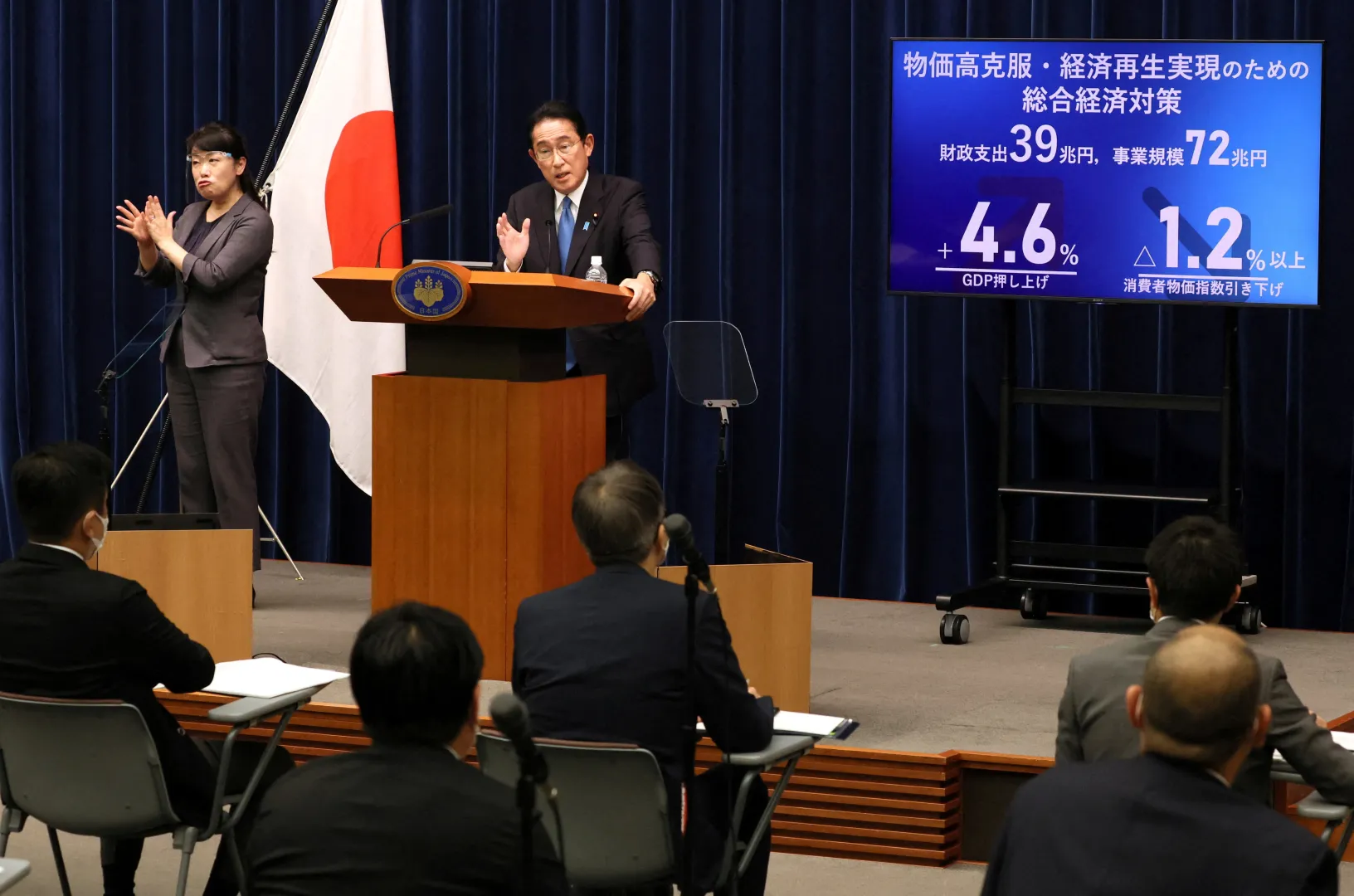In a bold response to mounting economic pressures, the Japanese government is preparing to unveil an unprecedented economic stimulus package valued at more than 20 trillion yen ($129 billion), according to sources familiar with the deliberations. The comprehensive package represents the government’s most ambitious effort yet to shield citizens from the persistent effects of inflation that have eroded household purchasing power and dampened consumer confidence across the archipelago.
The announcement, revealed by a government insider on Wednesday, comes at a critical juncture for the world’s third-largest economy, which has been grappling with rising living costs that have placed unprecedented strain on households and businesses alike. The stimulus measures signal a decisive shift in fiscal policy under Prime Minister Sanae Takaichi’s administration, which has pledged aggressive intervention to revitalize Japan’s inflation-plagued economy.
Build the future you deserve. Get started with our top-tier Online courses: ACCA, HESI A2, ATI TEAS 7, HESI EXIT, NCLEX-RN, NCLEX-PN, and Financial Literacy. Let Serrari Ed guide your path to success. Enroll today.
Comprehensive Support for Local Governments and Families
At the heart of the stimulus package lies a substantial allocation of 2 trillion yen earmarked for subsidies to local governments. This flexible funding mechanism will empower prefectural and municipal authorities to design and implement relief measures tailored to their communities’ specific needs, acknowledging that the impact of rising costs varies significantly across Japan’s diverse regions. From bustling metropolitan centers like Tokyo and Osaka to rural communities in Hokkaido and Kyushu, local officials will have the autonomy to deploy these resources where they are most urgently needed.
In a direct effort to support Japanese families, the government has allocated approximately 400 billion yen for a targeted cash handout program that will provide 20,000 yen per child. This initiative aims to ease the financial burden on households with children, who have been particularly affected by rising food prices and education costs. The handout will be distributed in addition to existing child allowances, providing immediate relief to families struggling to make ends meet in an environment of persistent inflation.
The stimulus measures, backed by a supplementary budget for the fiscal year ending March 2026, are expected to be approved by Prime Minister Takaichi’s Cabinet possibly on Friday. The comprehensive package will also include a gasoline tax cut, which ruling and opposition parties recently agreed to implement following extensive negotiations.
Record-Breaking Supplementary Budget
The extra budget is expected to reach 17 trillion yen, well above last year’s 13.9 trillion yen and marking the highest level since the end of the COVID-19 pandemic. This substantial increase reflects the government’s recognition of the severity of the economic challenges facing ordinary Japanese citizens and the urgent need for comprehensive intervention to prevent a deeper economic malaise.
Finance Minister Satsuki Katayama confirmed the scale of the package after meeting with Prime Minister Takaichi, signaling the administration’s commitment to prioritizing economic recovery and household relief over fiscal restraint. The decision to pursue such an expansive stimulus program marks a significant departure from Japan’s historically conservative approach to government spending, though it has raised concerns among some economists about the country’s long-term fiscal sustainability.
Economic Contraction Drives Urgent Policy Response
The aggressive stimulus measures come in response to troubling economic data that revealed Japan’s economy shrank for the first time in six quarters during the three months ending in September. The contraction, which saw GDP decline by 0.4% quarter-on-quarter and 1.8% on an annualized basis, reflected the impact of rising prices on consumer spending, which accounts for more than half of Japan’s economic output.
The economic slowdown was driven by multiple factors, including weakened exports due to US tariffs, a sharp decline in residential investment following the implementation of stricter energy conservation standards, and cautious household spending amid rising living costs. Private consumption grew by only 0.1% in the third quarter, reflecting the strain that inflation has placed on household budgets and the cautious approach many families are taking toward discretionary spending.
Prime Minister Takaichi has consistently pledged to prop up Japan’s inflation-plagued economy with aggressive fiscal spending, arguing that government intervention is necessary to prevent a return to the deflationary spiral that characterized Japan’s “Lost Decades” of economic stagnation. The administration’s proactive approach represents a significant gamble that increased government spending can stimulate economic activity without triggering unsustainable debt accumulation or undermining confidence in Japan’s fiscal management.
Market Concerns and Fiscal Health
In financial markets, investors have expressed growing concern about the impact of Takaichi’s economic policy on Japan’s fiscal health, prompting a selloff of the yen and government bonds in recent trading sessions. Market participants worry that the combination of massive stimulus spending and pressure on the Bank of Japan to maintain accommodative monetary policy could lead to currency depreciation and rising inflation without corresponding economic growth.
The concerns are not without foundation. As of 2023, Japan’s debt-to-gross domestic product ratio stood at approximately 195 percent according to government data, though some measurements place the figure even higher when accounting for all government liabilities. This represents one of the highest debt burdens among developed nations, raising questions about the sustainability of continued deficit spending and the government’s ability to service its mounting obligations.
Despite these concerns, government officials argue that Japan’s unique economic circumstances—including persistent deflationary pressures, an aging population, and the domestic ownership of most government debt—provide room for continued fiscal expansion. They contend that the immediate threat to economic stability comes not from government debt levels but from inadequate demand and the risk of renewed deflation, which could trigger a self-reinforcing cycle of economic decline.
Utility Bill Subsidies and Energy Cost Relief
Under the stimulus package, the government plans to allocate 500 billion yen in subsidies for electricity and gas bills for the first three months of next year, easing household costs by over 3,000 yen in January when energy usage tends to be highest due to winter heating demands. This targeted intervention recognizes that energy costs have become a particularly acute pain point for Japanese households, especially as global energy prices have remained elevated following various geopolitical disruptions.
The utility subsidies represent a continuation and expansion of similar programs implemented during previous periods of energy price volatility. By directly offsetting a portion of household energy costs, the government aims to preserve consumer purchasing power that would otherwise be consumed by utility bills, thereby supporting broader economic activity and preventing a further contraction in consumer spending.
One decision can change your entire career. Take that step with our Online courses in ACCA, HESI A2, ATI TEAS 7, HESI EXIT, NCLEX-RN, NCLEX-PN, and Financial Literacy. Join Serrari Ed and start building your brighter future today.
Gasoline Tax Reform and Transportation Cost Relief
The package will also include the implementation of a controversial gasoline tax cut that has been the subject of intense negotiations between ruling and opposition parties. Six parties—including the ruling Liberal Democratic Party, its coalition partner the Japan Innovation Party, the leading opposition Constitutional Democratic Party of Japan, the Democratic Party for the People, Komeito, and the Japanese Communist Party—reached an agreement to scrap the provisional surcharge on gasoline and gas oil taxes.
The surcharge, which stands at 25.1 yen per liter for gasoline and 17.1 yen for gas oil, has been in place for decades, originally introduced to fund public infrastructure projects. Its elimination is expected to provide immediate relief to drivers and businesses dependent on transportation, though it will also create a revenue shortfall of approximately 1.5 trillion yen that the government must address through alternative means.
To facilitate the transition and minimize market disruptions, the Ministry of Economy, Trade and Industry announced that it will gradually increase gasoline subsidies every two weeks, starting in mid-November, ultimately matching the provisional tax surcharge amount before the tax cut takes effect. This phased approach aims to prevent supply chain disruptions and hoarding behavior that could undermine the intended benefits of the tax reduction.
Local Government Flexibility and Community-Based Solutions
The package will also include substantial financial support for local governments to launch their own measures to deal with rising prices, with around 3,000 yen provided per person for initiatives such as rice vouchers and other food assistance programs. This decentralized approach acknowledges that the most effective solutions to cost-of-living challenges often vary significantly based on local circumstances, community needs, and existing social support infrastructure.
By empowering local governments with flexible funding, the stimulus package allows for innovation and experimentation in addressing inflation’s impact. Some municipalities may choose to focus on food assistance programs, while others might prioritize support for transportation costs, childcare, or elderly care services. This flexibility represents a pragmatic recognition that a one-size-fits-all approach to economic stimulus is unlikely to be optimal given Japan’s diverse economic and demographic landscape.
Political Implications and Coalition Dynamics
The stimulus package arrives at a politically sensitive moment for Prime Minister Takaichi’s administration, which must navigate complex coalition dynamics following recent electoral setbacks that left the ruling coalition without a clear majority in parliament. The cooperation between ruling and opposition parties on key elements of the package, particularly the gasoline tax cut, reflects both the urgency of the economic situation and the political necessity of finding common ground on measures to address rising living costs.
Opposition parties have leveraged their strengthened position to push for more aggressive relief measures, particularly regarding fuel taxes and direct cash transfers to households. The ruling coalition’s willingness to accommodate these demands demonstrates the political imperative of being seen as responsive to public concerns about inflation and cost-of-living pressures, even if such measures raise concerns about long-term fiscal sustainability.
Expert Perspectives and Economic Outlook
Economic analysts are divided on the likely effectiveness of the stimulus package. Goushi Kataoka, a private-sector member of a key government economic panel and former Bank of Japan board member, has argued that even larger stimulus measures may be necessary to offset the combined impact of weak domestic consumption, US tariffs, and rising living costs. Kataoka has called for a package potentially reaching 23 trillion yen when including tax cuts, suggesting that the currently proposed measures, while substantial, may prove insufficient to generate sustained economic recovery.
Other economists caution that fiscal stimulus alone cannot address the structural challenges facing Japan’s economy, including demographic decline, productivity stagnation, and the need for economic transformation in key industries. They argue that while short-term relief measures are necessary and appropriate given current economic conditions, the government must also pursue longer-term reforms to enhance competitiveness, innovation, and sustainable growth.
Analysts at major financial institutions, including Daiwa Securities, have noted that the total economic impact of the stimulus package could exceed 20 trillion yen when accounting for multiplier effects and related private sector activity. However, they also emphasize that the effectiveness of the package will depend critically on implementation details, timing, and coordination with monetary policy decisions by the Bank of Japan.
Bank of Japan and Monetary Policy Coordination
The stimulus package’s announcement has significant implications for Bank of Japan monetary policy decisions. Market participants had widely expected the central bank to raise interest rates in December or January, continuing its gradual normalization of monetary policy following years of ultra-accommodative measures. However, the combination of economic contraction in the third quarter and the implementation of massive fiscal stimulus has complicated the central bank’s decision-making calculus.
Some analysts now argue that the Bank of Japan should delay any rate increases until at least March or April to allow time to assess the stimulus package’s impact on economic growth and to gather more data on wage negotiations scheduled for early 2026. The concern is that premature monetary tightening could undermine the stimulative effects of fiscal policy and potentially push the economy back toward deflation.
However, others worry that delaying rate increases while implementing massive fiscal stimulus could further weaken the yen, potentially exacerbating inflation pressures by increasing import costs. This dilemma reflects the challenging balancing act facing Japanese policymakers as they attempt to support economic growth while managing inflation expectations and maintaining currency stability.
Long-Term Fiscal Sustainability Concerns
While the immediate focus remains on addressing current economic challenges, the stimulus package inevitably raises questions about Japan’s long-term fiscal sustainability. With government debt already exceeding 230 percent of GDP by most comprehensive measures, and with demographic trends pointing toward continued pressure on social security systems, some economists worry that continued reliance on deficit spending could eventually undermine confidence in Japan’s fiscal position.
Proponents of the stimulus package counter that Japan’s circumstances differ significantly from other highly indebted nations. They point to the fact that approximately 88 percent of Japanese government debt is held domestically, reducing vulnerability to foreign investor sentiment and currency crises. Additionally, they note that Japan’s substantial net foreign assets and the government’s ownership of valuable domestic assets partially offset gross debt levels.
Nevertheless, the servicing of national debt already consumes approximately 22 percent of the Japanese national budget, limiting the government’s fiscal flexibility for other priorities. As the population continues to age and the workforce shrinks, this debt service burden may become increasingly challenging to manage, particularly if interest rates rise from their current historically low levels.
Looking Ahead: Implementation and Impact
The success of the stimulus package will ultimately depend on effective implementation and the broader economic environment in which it operates. Key factors that will influence outcomes include the trajectory of global economic growth, particularly in major trading partners like the United States and China; the evolution of energy prices and other commodity costs; the stability of the yen and its impact on import prices; and the response of businesses and households to the various stimulus measures.
Government officials have emphasized their commitment to monitoring the package’s effects closely and making adjustments as necessary to ensure that relief reaches intended beneficiaries and that economic activity responds as anticipated. They have also stressed the importance of coordinating fiscal policy with monetary policy and structural reforms to maximize the stimulus package’s effectiveness in supporting sustainable economic recovery.
As Japan moves forward with this historic economic intervention, the coming months will provide crucial evidence about the effectiveness of large-scale fiscal stimulus in addressing cost-of-living challenges and revitalizing economic growth in an advanced economy facing significant structural headwinds. The outcomes will have implications not only for Japan but also for other developed nations grappling with similar challenges of aging populations, elevated debt levels, and the need to balance short-term economic support with long-term fiscal sustainability.
Ready to take your career to the next level? Join our Online courses: ACCA, HESI A2, ATI TEAS 7 , HESI EXIT , NCLEX – RN and NCLEX – PN, Financial Literacy!🌟 Dive into a world of opportunities and empower yourself for success. Explore more at Serrari Ed and start your exciting journey today! ✨
Track GDP, Inflation and Central Bank rates for top African markets with Serrari’s comparator tool.
See today’s Treasury bonds and Money market funds movement across financial service providers in Kenya, using Serrari’s comparator tools.
photo source: Google
By: Montel Kamau
Serrari Financial Analyst
20th November, 2025
Article, Financial and News Disclaimer
The Value of a Financial Advisor
While this article offers valuable insights, it is essential to recognize that personal finance can be highly complex and unique to each individual. A financial advisor provides professional expertise and personalized guidance to help you make well-informed decisions tailored to your specific circumstances and goals.
Beyond offering knowledge, a financial advisor serves as a trusted partner to help you stay disciplined, avoid common pitfalls, and remain focused on your long-term objectives. Their perspective and experience can complement your own efforts, enhancing your financial well-being and ensuring a more confident approach to managing your finances.
Disclaimer: This article is for informational purposes only and does not constitute financial advice. Readers are encouraged to consult a licensed financial advisor to obtain guidance specific to their financial situation.
Article and News Disclaimer
The information provided on www.serrarigroup.com is for general informational purposes only. While we strive to keep the information up to date and accurate, we make no representations or warranties of any kind, express or implied, about the completeness, accuracy, reliability, suitability, or availability with respect to the website or the information, products, services, or related graphics contained on the website for any purpose. Any reliance you place on such information is therefore strictly at your own risk.
www.serrarigroup.com is not responsible for any errors or omissions, or for the results obtained from the use of this information. All information on the website is provided on an as-is basis, with no guarantee of completeness, accuracy, timeliness, or of the results obtained from the use of this information, and without warranty of any kind, express or implied, including but not limited to warranties of performance, merchantability, and fitness for a particular purpose.
In no event will www.serrarigroup.com be liable to you or anyone else for any decision made or action taken in reliance on the information provided on the website or for any consequential, special, or similar damages, even if advised of the possibility of such damages.
The articles, news, and information presented on www.serrarigroup.com reflect the opinions of the respective authors and contributors and do not necessarily represent the views of the website or its management. Any views or opinions expressed are solely those of the individual authors and do not represent the website's views or opinions as a whole.
The content on www.serrarigroup.com may include links to external websites, which are provided for convenience and informational purposes only. We have no control over the nature, content, and availability of those sites. The inclusion of any links does not necessarily imply a recommendation or endorsement of the views expressed within them.
Every effort is made to keep the website up and running smoothly. However, www.serrarigroup.com takes no responsibility for, and will not be liable for, the website being temporarily unavailable due to technical issues beyond our control.
Please note that laws, regulations, and information can change rapidly, and we advise you to conduct further research and seek professional advice when necessary.
By using www.serrarigroup.com, you agree to this disclaimer and its terms. If you do not agree with this disclaimer, please do not use the website.
www.serrarigroup.com, reserves the right to update, modify, or remove any part of this disclaimer without prior notice. It is your responsibility to review this disclaimer periodically for changes.
Serrari Group 2025











